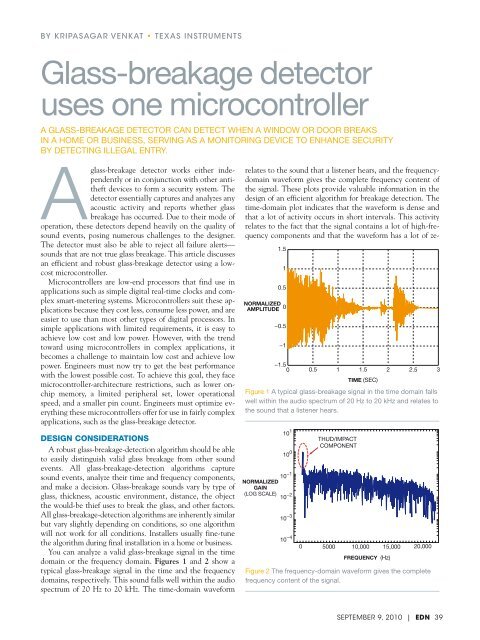VOICE OF THE ENGINEER - ElectronicsAndBooks
VOICE OF THE ENGINEER - ElectronicsAndBooks
VOICE OF THE ENGINEER - ElectronicsAndBooks
- No tags were found...
Create successful ePaper yourself
Turn your PDF publications into a flip-book with our unique Google optimized e-Paper software.
BY KRIPASAGAR VENKAT • TEXAS INSTRUMENTSGlass-breakage detectoruses one microcontrollerA GLASS-BREAKAGE DETECTOR CAN DETECT WHEN A WINDOW OR DOOR BREAKSIN A HOME OR BUSINESS, SERVING AS A MONITORING DEVICE TO ENHANCE SECURITYBY DETECTING ILLEGAL ENTRY.Aglass-breakage detector works either independentlyor in conjunction with other antitheftdevices to form a security system. Thedetector essentially captures and analyzes anyacoustic activity and reports whether glassbreakage has occurred. Due to their mode ofoperation, these detectors depend heavily on the quality ofsound events, posing numerous challenges to the designer.The detector must also be able to reject all failure alerts—1.5sounds that are not true glass breakage. This article discussesan efficient and robust glass-breakage detector using a lowcostmicrocontroller.1Microcontrollers are low-end processors that find use in0.5applications such as simple digital real-time clocks and complexsmart-metering systems. Microcontrollers suit these applicationsbecause they cost less, consume less power, and are AMPLITUDE 0NORMALIZEDeasier to use than most other types of digital processors. Insimple applications with limited requirements, it is easy to−0.5achieve low cost and low power. However, with the trendtoward using microcontrollers in complex applications, it−1becomes a challenge to maintain low cost and achieve lowpower. Engineers must now try to get the best performance−1.50 0.5 1 1.5 2with the lowest possible cost. To achieve this goal, they faceTIME (SEC)microcontroller-architecture restrictions, such as lower onchipmemory, a limited peripheral set, lower operationalspeed, and a smaller pin count. Engineers must optimize everythingthese microcontrollers offer for use in fairly complexapplications, such as the glass-breakage detector.relates to the sound that a listener hears, and the frequencydomainwaveform gives the complete frequency content ofthe signal. These plots provide valuable information in thedesign of an efficient algorithm for breakage detection. Thetime-domain plot indicates that the waveform is dense andthat a lot of activity occurs in short intervals. This activityrelates to the fact that the signal contains a lot of high-frequencycomponents and that the waveform has a lot of ze-Figure 1 A typical glass-breakage signal in the time domain fallswell within the audio spectrum of 20 Hz to 20 kHz and relates tothe sound that a listener hears.2.53DESIGN CONSIDERATIONSA robust glass-breakage-detection algorithm should be ableto easily distinguish valid glass breakage from other soundevents. All glass-breakage-detection algorithms capturesound events, analyze their time and frequency components,and make a decision. Glass-breakage sounds vary by type ofglass, thickness, acoustic environment, distance, the objectthe would-be thief uses to break the glass, and other factors.All glass-breakage-detection algorithms are inherently similarbut vary slightly depending on conditions, so one algorithmwill not work for all conditions. Installers usually fine-tunethe algorithm during final installation in a home or business.You can analyze a valid glass-breakage signal in the timedomain or the frequency domain. Figures 1 and 2 show atypical glass-breakage signal in the time and the frequencydomains, respectively. This sound falls well within the audiospectrum of 20 Hz to 20 kHz. The time-domain waveformNORMALIZEDGAIN(LOG SCALE)10 1 THUD/IMPACTCOMPONENT10 010 −110 −210 −310 −40 5000 10,000 15,000 20,000FREQUENCY (Hz)Figure 2 The frequency-domain waveform gives the completefrequency content of the signal.SEPTEMBER 9, 2010 | EDN 39






![[270].pdf 37407KB Sep 02 2010 09:55:57 AM - ElectronicsAndBooks](https://img.yumpu.com/50350834/1/185x260/270pdf-37407kb-sep-02-2010-095557-am-electronicsandbooks.jpg?quality=85)
![draaien, A Viruly 1935 OCR c20130324 [320]. - ElectronicsAndBooks](https://img.yumpu.com/49957773/1/190x252/draaien-a-viruly-1935-ocr-c20130324-320-electronicsandbooks.jpg?quality=85)


![20051110 c20051031 [105].pdf 35001KB Feb 18 2009 08:46:32 PM](https://img.yumpu.com/48687202/1/190x253/20051110-c20051031-105pdf-35001kb-feb-18-2009-084632-pm.jpg?quality=85)





